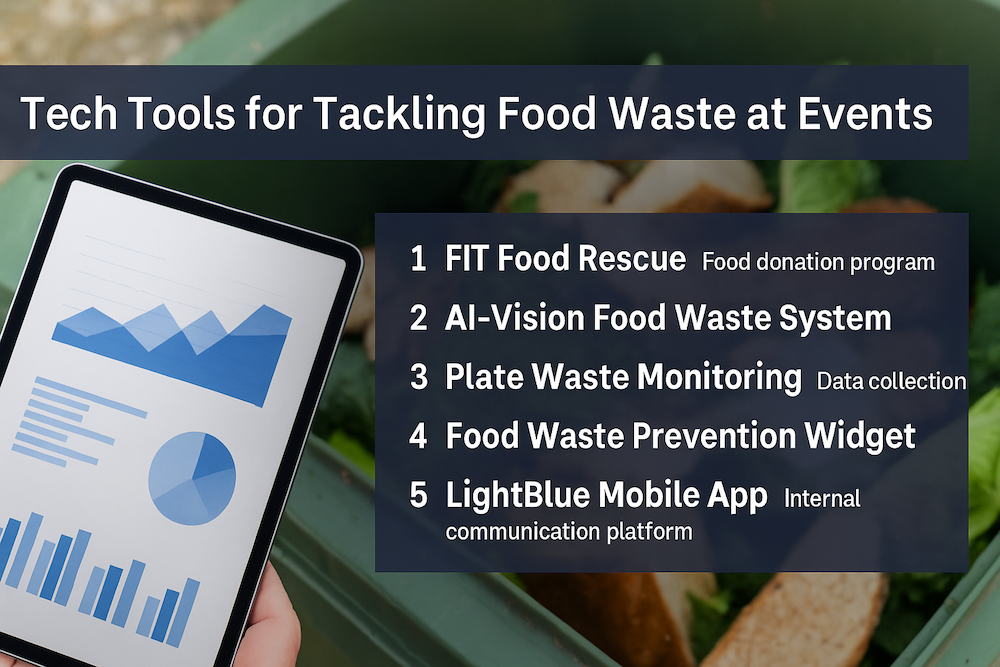From kitchen tracking to AI forecasting, these five tools help planners cut waste, save money, and run more sustainable events
Every planner knows the pain: a banquet buffet groaning with food at the start of the night, and trash bins groaning with waste by the end. Globally, food waste contributes an estimated 8–10% of greenhouse gas emissions (UNEP), and in the events sector it often accounts for up to 20% of all food served (ICCA). That waste doesn’t just hit the planet — it dents catering budgets and reputations too.
The good news: technology is stepping up. From real-time kitchen dashboards to apps that match leftovers with local charities, new tools are helping planners and venues see, measure, and slash their food waste. Here are five innovations every event professional should know about.
1. FIT (Food Intel Tech) – Turning Kitchen Waste into Data
FIT, developed by LightBlue Consulting, is one of the most practical, proven platforms available. Installed on a tablet and connected to a scale, it allows chefs to log what gets thrown away, in what quantities, and why.
Impact: LightBlue reports average 25–35% reductions in food waste, with kitchens often trimming 3–5% off food costs. A Spanish hotel saved $182,000 in one year, preventing 120 tons of CO₂ emissions.
Planner takeaway: FIT gives concrete data you can share in post-event sustainability reports, showing sponsors and attendees measurable progress.
2. AI Forecasting Tools – Smarter Menu Planning
Chronic over-ordering has long plagued conferences. Emerging AI-powered forecasting platforms like FoodStorm are tackling this by analyzing past event data, attendee demographics, and even dietary preferences to predict more accurate portion sizes.
Impact: Hotels using predictive menu tech have cut overproduction by double digits, with fewer untouched trays of food at buffets.
Planner takeaway: Pair forecasting tools with your registration data — you’ll cut waste and costs without compromising variety.
3. Surplus Donation Apps – Connecting Kitchens to Communities
Even the best forecasts can’t prevent all surplus. That’s where donation platforms like Too Good To Go or regional food-rescue apps come in. They match leftover meals from hotels or venues with charities and community groups that can use them immediately.
Impact: At ICCA’s 2024 Congress in Abu Dhabi, this approach helped redistribute 928 meals and save nearly 400 kg of food from landfill.
Planner takeaway: Build donation logistics into your RFPs. A redistribution plan not only reduces disposal costs but also creates a positive story for your event’s legacy.
4. Smart Kitchen Hardware – Sensors & Connected Scales
Beyond software, a new generation of IoT-enabled kitchen equipment is giving F&B teams real-time visibility on spoilage and stock. Smart fridges send alerts when food risks expiring, while connected scales automatically log trimmings and scraps.
Impact: Early adopters in resort kitchens have reported measurable reductions in spoilage and over-prep.
Planner takeaway: Ask your venue partners if they’re investing in smart kitchen tech. Those who are will have an easier time meeting your sustainability goals.
5. Data Dashboards & ESG Reporting Platforms
Collecting data is one thing — presenting it to stakeholders is another. Sustainability dashboards now integrate food waste tracking into broader ESG (Environmental, Social, Governance) reporting systems. They translate kitchen logs into impact metrics like CO₂ avoided, meals saved, or dollars reduced.
Impact: Mauritius hotels in a LightBlue-led program logged a 43% reduction in food waste across 10 organizations, saving 125,000 meals and $210,000 in under a year.
Planner takeaway: Sponsors increasingly expect ESG reporting. A dashboard that visualizes your food waste reductions adds credibility — and can help secure future funding.
FURTHER READING: TURNING THE TABLES ON FOOD WASTE
Why Tech is the Game-Changer
As Benjamin Lephilibert of LightBlue says, “Turning waste into data, and data into action, is the fastest path to impact.” For planners, these five tools are more than back-of-house gadgets: they’re front-line assets that reduce costs, impress stakeholders, and align your events with rising sustainability expectations.
The banquet table may never be waste-free — but with the right technology, it can be smarter, leaner, and far more sustainable. For an industry that thrives on memorable experiences, ensuring meals nourish people instead of landfills may be the most important legacy planners can leave behind.
Any thoughts, opinions, or news? Please share them with me at vince@meetingsevents.com.
Photo by OpenAI’s DALL·E





